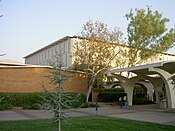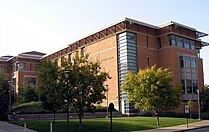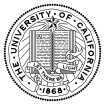University of California, Riverside
This article contains promotional material. (July 2023) ) |
WSCUC | |
Academic affiliation | |
|---|---|
| Endowment | $259.8 million (2019)[3] |
| Budget | $1.062 billion (2016-2017)[4] |
| Chancellor | Kim A. Wilcox |
| Provost | Elizabeth Watkins[5] |
Academic staff | 1,638[6] |
Administrative staff | 1,938[6] |
| Students | 26,809 (2022)[7] |
| Undergraduates | 22,903 (2022)[7] |
| Postgraduates | 3,906 (2022)[7] |
| Location | , , United States |
| Campus | Large city, 2,131 acres (862 ha)[8] |
| Other campuses | Palm Desert |
| Newspaper | The Highlander |
| Colors | Blue and gold[9] |
| Nickname | Highlanders |
Sporting affiliations | |
| Mascot | Scotty Highlander |
| Website | www |
 | |
The University of California, Riverside (UCR or UC Riverside) is a
UCR's undergraduate
In 2000, UC Riverside was
History

At the turn of the 20th century,
The 1944 passage of the
Gordon S. Watkins, dean of the UCLA College of Letters and Science, became the first provost of the new college at Riverside. Initially conceived of as a small college devoted to the liberal arts, he ordered the campus built for a maximum of 1,500 students and recruited many young junior faculty to fill teaching positions.[19] He presided at its opening with 65 faculty and 127 students on February 14, 1954, remarking, "Never have so few been taught by so many."[20]
UCR's enrollment exceeded 1,000 students by the time

In the 1990s, UC experienced a new surge of enrollment applications, now known as "Tidal Wave II".
With UCR scheduled for dramatic population growth, efforts have been made to increase its popular and academic recognition.[30] The students voted for a fee increase to move UCR athletics into NCAA Division I standing in 1998.[31] In the 1990s, proposals were made to establish a law school, a medical school, and a school of public policy at UCR, with the UCR School of Medicine and the School of Public Policy becoming reality in 2012.[32] In June 2006, UCR received its largest gift, 15.5 million from two local couples, in trust towards building its medical school.[33] The Regents formally approved UCR's medical school proposal in 2006. Upon its completion in 2013, it was the first new medical school built in California in 40 years.[34][35]
Campus

UCR's main campus sits at an elevation of 1,100 ft (340 m) to 1,450 ft (440 m) near Box Springs Mountain, 3 miles (5 km) east of downtown Riverside, 3 miles (5 km) south of neighboring
East Campus, occupying approximately 600 acres (243 ha), hosts the core cluster of academic buildings and services. The original buildings that formed the earliest kernel of the campus included the UC Citrus Experiment Station, residential buildings, and barn, all of which are still in use. They were designed by Lester H. Hibbard, in association with H.B. Cody. Built by 1917 at a cost of $165,000, the
Further major construction largely ceased on the site until the groundbreaking for the College of Humanities Arts and Social Sciences (CHASS) in April 1951. A group of five buildings designed by different architects in a decidedly more Modern style were completed by 1954: the Rivera Library, Webber Hall, Geology Building, Physical Education Building and Watkins Hall. After the Regents declared UCR a "general campus" of the UC system in 1958, many new buildings and additions were laid out over the following decade. Following an east–west axis, new student residence halls and athletic facilities were developed along the southeastern quadrant of the main campus, while academic and research facilities were built along the central campus area closer to the freeway.[30] The Bell Tower, one of only five carillons in California, was built in this period. Designed by A. Quincy Jones, the tower is 161 ft (49 m) tall and contains 48 bells, each weighing from 28 pounds (13 kg) to 5,091 pounds (2,309 kg), covering four chromatic octaves.[37]


After the drop in enrollment and subsequent restructuring of academic programs in the 1970s, little capacity construction was undertaken over the next two decades. However, enrollment growth in the late 1980s justified considerable further campus expansion over the 1990s. Major additions built in the period include:

Of the 511 acres (207 ha) of UCR property constituting West Campus, approximately 216 acres (87 ha) along University Avenue have been developed. These include facilities such as University Extension, the United States Department of Agriculture (USDA) Germplasm Repository, International Village (student housing), Human Resources and Highlander Hall. University Village, a mixed use commercial development, features a movie theater, stores, restaurants, office space, and an apartment complex, along with a parking structure and surface parking. Citrus groves and row crops occupy the remaining 295 acres (119 ha) stretching northwest to the intersection of Chicago Avenue and Le Conte Drive. Plans for future expansion include converting a portion of these fields into new UCR infrastructure.[30]
The University of California, Riverside, has recently united its three downtown arts presentation venues under the umbrella name of the UCR ARTSblock. The ARTSblock is composed of the UCR/California Museum of Photography, The Sweeney Art Gallery, and the Culver Center of the Arts, a media lab and presentation facility. The three institutions reside side by side in the heart of downtown Riverside's historic
Palm Desert Graduate Center
The Richard J. Heckmann International Center for Entrepreneurial Management was founded in
Academics
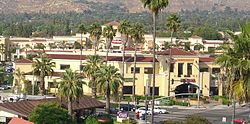
As a campus of the University of California system, UCR is governed by a Board of Regents and administered by a president. The current president is Michael V. Drake, and the current chancellor of the university is Kim A. Wilcox. UCR's academic policies are set by its Academic Senate, a legislative body composed of all UCR faculty members.[46]
UCR is organized into three academic colleges, two professional schools, and two graduate schools. UCR's liberal arts college, the College of Humanities, Arts and Social Sciences, was founded in 1954, and began accepting graduate students in 1960. The
Rankings
|
|
| |||||||||||||||||||||||||||||||||||||||||||||||||||||||||||||||||||||||||||||||||||||||||||||||||||||||||
Historical rankings
| 1pq | 2024 | 2023 | 2022 | 2021 | 2020 | 2019 |
|---|---|---|---|---|---|---|
| ARWU[70] | 62–82 | 63–85 | 63–89 | 66–94 | 59–66 | 59–60 |
| Forbes | 75 | 84 | 101 | - | - | 199 |
| Money[71] | 4.5/5.0 | 40 | 48 | 12 | 32 | 29 |
| U.S. News & World Report | 76 | 89 | 83 | 88 | 91 | 85 |
| Wall Street Journal | 181 | 184 | 192 | 192 | 189 | 272 |
| Washington Monthly | 64 | 69 | 53 | 27 | 27 | 28 |
Research and economic impact
UCR operated under a $727 million budget in fiscal year 2014–15.
Throughout UCR's history, researchers have developed more than 40 new citrus varieties and invented new techniques to help the $960 million-a-year California
To assist entrepreneurs in developing new products, UCR is a primary partner in the Riverside Regional Technology Park, which includes the City of Riverside and the
Admissions and enrollment
| Undergraduate admissions statistics | |
|---|---|
2019 entering class GPA | |
| Average | 3.87 ( |
Admission to UC Riverside is rated as "more selective" by U.S. News & World Report.[81]
For Fall 2018, UCR received 49,079 freshmen applications; 24,820 were admitted (50.6%).
In 2006, 43.4 percent of admitted students were first generation college students, 38.7 percent came from low family income backgrounds, and 24 percent graduated from low-performing high schools as measured by
According to statistics released by the Education Trust, a national nonprofit, in 2005 UC Riverside graduated 65.3 percent of its students in six years, a figure consistent with national averages but behind the average set by the top five public research universities by as much as 22 percent.[87][88] However, UCR's consistency with the national average is well above the median of 39 percent for low-income-serving institutions as calculated in 2006 by the National Center for Education Statistics, making the campus a model for successful approaches to diversity in higher education.[89]
Libraries and collections
Total
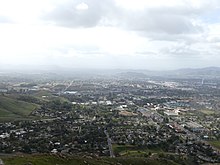
UCR's academic colleges administer significant
The
Student life
| Race and ethnicity[103] | Total | ||
|---|---|---|---|
| Hispanic | 38.7% | ||
| Asian | 30.8% | ||
| White | 12.9% | ||
International
|
7.5% | ||
| Other[a] | 5.7% | ||
| Black | 3.0% | ||
| Economic diversity (2020) | |||
| Affluent[b] | 51% | ||
| Low-income[c] | 49% | ||
Much of the student life on campus revolves around extensive local outreach and retention programs. Riverside enrolls the highest percentage of African American students of any of the 10 UC campuses and the second highest percentage of Latino students after Merced, prompting the
Housing
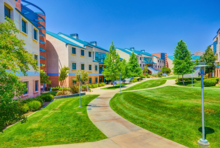

UCR's residence halls consist of four structures—Aberdeen-Inverness, Dundee, Lothian, and Pentland Hills—which can house over 3,000 students in double and triple rooms.
Reflecting UCR's diversity, a number of residence halls have been established for specific social, cultural and academic needs. Ethnic and gender-oriented theme halls include Unete a Mundo, for students seeking to support Latino or Chicano students in acclimating to life at UCR; a Pan African Theme Hall for students interested in developing consciousness of African culture in relation to other cultures of the world; and Stonewall Hall, dedicated to students of all gender identities and sexual orientations who wish to live in a
In Fall 2018, UCR began construction of a new residence hall and dining facility in the parking lot behind Aberdeen-Inverness.[115] This new residence hall and dining facility opened as Dundee-Glasgow in 2020, and features UCR's first two-story residential restaurant.[116]
Student organizations and activities
UCR hosts over 500 registered student organizations, including the Associated Students of the University of California, Riverside (ASUCR), which represents undergraduates on administrative and policy issues.[117] ASUCR is guided by a Senate composed of 16 elected senators, who represent the three undergraduate colleges in proportion to their enrollment, 5 Executive Cabinet Officers (President, Executive Vice President, Vice President of Campus Internal Affairs, Vice President of External Affairs, and Vice President of Finance), and 6 Directors, who are in charge of the various parts of ASUCR, and a Judicial Council of 6, which adjudicates any cases involving personnel misconduct or interpretation of the Constitution. Membership is composed of all UCR students who pay mandatory activity fees.[118] ASUCR assesses these fees and distributes funds to registered student groups on campus, including student lobbying groups, a right that ASUCR won in a federal court case against the Regents in 1999.[119]
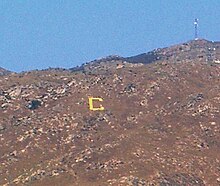
Of the registered student groups, 40 are fraternities and sororities. Nine men's fraternities belong to the North American Interfraternity Conference; seven women's sororities belong to the National Panhellenic Conference; seven men's fraternities and ten women's sororities represent the National Multicultural Greek Council, and two others fall under the campus Raza Assembly and are unique to UCR.[122] Thirteen percent of the undergraduate student body participates in Greek life, although chapter houses are not permitted.[123] Including the Greek letter organizations, more than 60 student volunteer service organizations at UCR contribute to more than 100,000 hours of collective and individual service done in the community each year.[124] Jewish student life has existed for over a decade through UCR Hillel.[125]
Student media organizations include The Highlander student newspaper, currently published every Tuesday during the academic year. First published in 1954, The Highlander remains an independent student media outlet. It was an entirely self-funded organization until 2001, when ASUCR passed a funding referendum for it. Student fees from the referendum go towards overhead and printing costs, however The Highlander is primarily funded through its own advertising revenue.
On-campus entertainment events are planned by a 14-member Associated Students Program Board (ASPB), comprising six student-run divisions that include concerts, films and lectures, cultural events and special events, as well as a marketing and leadership division. ASPB's major events include the Block Party Concert, Winter Soulstice, Homecoming Bonfire and Spring Splash.[133]
Still other on-campus events take place at The Barn, one of the original buildings on campus grounds. Throughout the 60s', 70s' and 80s' popular up and coming bands played at The Barn including No Doubt and Radiohead. During the 90s' however, the university administration sought to avoid a "party school" stigma and did away with the concerts and events and remodeled the facility into a restaurant, The Big West Bar and Grill. As recently as the fall of 2007, concerts returned to The Barn and efforts are underway to rejuvenate it and once again make it into an on-campus venue attracting students as well as the larger university community.
The Graduate Student Association of the University of California, Riverside (GSAUCR) is ASUCR's counterpart on the graduate level. It is guided by a Graduate Student Council consisting of representatives from every department on campus. GSAUCR assesses fees required of all graduate students and uses them to fund research awards and colloquiums, conference travel grants, and speaker funds.[134]
Athletics
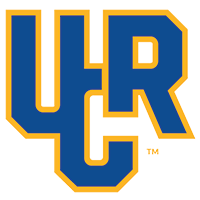

UCR's
In 2005 the women's soccer team competed in the first round of the NCAA tournament.[138] In 2007, UCR's baseball team won their first Big West championship and reached the Division I postseason for the second time since 2003, and the cross country team sent its first two athletes to the national championships.[139][140] Football was played until 1975, and the team won two CCAA championships before the sport was discontinued because of low attendance and in anticipation of the impact of Title IX regulations.[141]
The volleyball and basketball teams play home games in the
Non-varsity student sports clubs that compete with other area universities include the Rugby Football Club, established in 2006, which plays in the Southern California Rugby Football Union.[146] The karate program is provided through the UC Riverside Recreation Center's Leisure Line classes. The classes are provided by top-of-the-line USA Shotokan karate team coaches from the American JKA Karate Association, an association that has been in the city for over 40 years. It is one of the largest collegiate programs in the United States, that take competitors to local, national and international competitions. UCR also has a Boxing club that competes in the USIBA College National Championships and trains at a local gym named the Raincross Boxing Academy[147] A Men's and Women's Club Soccer team also competes in the West Coast Soccer Association.[148]
In 1954, UCR's founding class adopted the name "Highlanders", reflecting the campus' high altitude. After the student body passed a referendum to move to Division I competition in 1998, the bear mascot, formerly called "Scotty", was professionally redesigned to look more ferocious.
National Championship Teams (Division II)
- Baseball (1977 and 1982).
- Women's Volleyball (1977 – AIAW, 1982 and 1986).
- Women's Soccer (1983) First place in the California Collegiate Women's Soccer Conference.
Notable people
Alumni
More than 94,000 alumni have graduated from UCR over the course of its history.[153] A 13,865-square-foot (1,288.1 m2) Alumni and Visitors Center was established in 2007. It is used as a central gathering place for alumni and holds several facilities for use including meeting rooms, a formal board room, a central lobby area, a library, several alumni affairs offices, and a café.[154]
Some of the most notable alumni include:
- Steve Breen – editorial cartoonist and two time Pulitzer Prize winner (1998 and 2009)[155]
- Poet Laureate[155]
- Sherilyn Peace Garnett, federal judge for the United States District Court for the Central District of California, since 2023
- Joe Kelly – professional baseball player
- 2016 Rio de Janeiro Olympics for the 1500 meter track event[155]
- Laurent Charlet – geochemist and professor at the University of Grenoble-Alpes
- Joanna Cameron - actress and model The Secrets of Isis
- Anil Raj – former Amnesty International board member and UNDP aid worker killed in a terror attack in Kabul in November 2019[156][157]
- Richard R. Schrock – physicist, Nobel Prize in Chemistry laureate[155]
- Judy Shapiro-Ikenberry – long-distance runner
- Charles E. Young – UCR's first student body president, later Chancellor of UCLA
Faculty
- Chris Abani – author, member of the American Academy of Arts and Sciences
- Reza Aslan – author, researcher, member of the Council on Foreign Relations
- John C. Baez – physicist, researcher focused on loop quantum gravity
- Barry Barish – physicist, Nobel Prize in Physics laureate
- Casey Charles – author
- Mike Davis – historian, MacArthur Fellows Program recipient
- Kim Yi Dionne – political scientist
- Steve Erickson – author
- John Martin Fischer – philosopher
- Edwin Gaustad – historian, president of the American Society of Church History
- Gail Hanson – physicist, Panofsky Prize recipient
- Nalo Hopkinson – author, World Fantasy Award recipient
- Anne Kernan – an Irish particle physicist
- Laila Lalami – author, American Book Awards recipient
- Perry Link – author, professor of foreign languages
- Sonja Lyubomirsky – psychologist, author of the bestseller The How of Happiness: A Scientific Approach to Getting the Life You Want[158]
- Wilbur Waldo Mayhew – biologist and founding member of the Department of Biology
- Robert Nisbet – sociologist
- Richard R. Schrock – chemist, Nobel Prize in Chemistry laureate
- Robert Rosenthal – psychologist, Guggenheim Fellowship recipient
- Jane Smiley – author, Pulitzer Prize recipient
- Harry Scott Smith – entomologist
- Edgar Awardrecipient
- Karl Taube – archeologist, researcher focused on pre-Columbian civilization
See also
- University of California Students Association
- Cahuilla peopleleader and scholar, received the Chancellor's Medal from UCR
Notes
- ^ Other consists of Multiracial Americans & those who prefer to not say.
- ^ The percentage of students who are a part of the American middle class at the bare minimum.
- Pell grantintended for low-income students.
References
- ^ "A brief history of the University of California". Academic Personnel and Programs. The University of California, Office of the President. Archived from the original on October 21, 2020. Retrieved October 17, 2017.
- ^ "UCR History".
- ^ As of June 30, 2019; includes UC Regents portion allocated to UC Riverside. "Annual Endowment Report for the Fiscal Year Ended June 30, 2019" (PDF). University of California. Retrieved February 3, 2020.
- ^ "UCR Budget Primer 2016-2017" (PDF). University of California, Riverside. Archived from the original (PDF) on May 18, 2018. Retrieved May 24, 2017.
- ^ "Office of the Provost". University of California, Riverside. Retrieved November 17, 2020.
- ^ a b "Academic and PSS personnel" (PDF). University of California, Office of the President, Department of Information Resources and Communications. 2007. Archived from the original (PDF) on May 16, 2008. Retrieved January 5, 2008.
- ^ a b c "About UCR: Ranks and Facts". University of California, Riverside. Retrieved May 10, 2023.
- ^ "University of California Annual Financial Report 18/19" (PDF). University of California. p. 9. Retrieved October 12, 2020.
- ^ "UC Riverside Colors | Brand Identity". June 13, 2020. Retrieved July 13, 2020.
- ^ "UCR Factsheet". University of California, Riverside. Archived from the original on August 20, 2007. Retrieved August 22, 2007.
- ^ a b c d e "UCR Facts and Impacts 2007". University of California, Riverside. Retrieved August 20, 2007.
- ^ Muckenfuss, Mark (October 2, 2012). "Medical school receives preliminary accreditation". The Press-Enterprise. Archived from the original on November 16, 2012. Retrieved October 31, 2012.
- ^ The Carnegie Classification of Institutions of Higher Education (Report) (2000 ed.). The Carnegie Foundation for the Advancement of Teaching. 2001. Retrieved April 15, 2023.
- ^ "Carnegie Classifications Institution Lookup". carnegieclassifications.iu.edu. Center for Postsecondary Education. Retrieved July 19, 2020.
- ISBN 0-931876-87-7. Archived from the original(PDF) on August 8, 2007. Retrieved August 21, 2007.
- ^ a b "University of California, Riverside Campus Timeline" (Press release). UCR News. 2002. Archived from the original on October 17, 2002. Retrieved January 10, 2008.
- ^ "Gabbert Oral History transcript" (PDF). University of California, Riverside, Oral History Project. April 2, 1998. Retrieved August 22, 2007.
- ^ Lovekin, Kris (February 2004). "Enjoying Our Past". Fiat Lux. 14 (2). University of California, Riverside: 14–17. Archived from the original on February 13, 2009. Retrieved August 22, 2007.
- ^ "Adrian Oral History Transcript" (PDF). University of California, Riverside Oral History Project. July 2, 1998. Retrieved January 10, 2007.
- Press Enterprise. Retrieved August 20, 2007.
- ^ Stadtman, Verne A. (1967). "The Centennial Record of the University of California". Office of the Regents of the University of California, Office of the Secretary. Retrieved August 10, 2007.
- ISBN 0-520-22367-5. Retrieved January 10, 2007.
- ^ a b c d e f "Hinderaker Oral History Transcript" (PDF). University of California, Riverside Oral History Project. May 5, 1998. Retrieved January 10, 2008.
- ^ "Academic Planning and Budget: Year-Avg Headcount Enrollment". Institutional Planning, Office of Planning and Budget, University of California, Riverside. Retrieved March 22, 2008.
- Press Enterprise. Archived from the originalon February 15, 2009. Retrieved September 26, 2007.
- ^ Hayward, Gerald C.; Brenman, David W.; Estrada, Leobardo F. (September 1998). "Tidal Wave II Revisited, A Review of Earlier Enrollment Projections For CA Higher Education" (PDF). San Jose and Washington, D.C.: National Center for Public Policy and Higher Education. Retrieved August 21, 2007.
- ^ "UC Enrollment Growth" (PDF) (Press release). News and Communications, University of California, Office of the President. Archived from the original (PDF) on August 8, 2007. Retrieved August 22, 2007.
- ^ Robinson, Nina (March 2003). "Undergraduate Access to the University of California After the Elimination of Race Conscious Policies" (PDF). Oakland: UC Office of the President. Archived from the original (PDF) on August 8, 2007. Retrieved August 21, 2007.
- Press Enterprise. Retrieved August 21, 2007.[permanent dead link]
- ^ a b c d e f "UCR's Long Range Development Plan" (PDF). University of California, Riverside, Office of Academic Planning & Budget, Capital & Physical Planning. October 2005. Archived from the original (PDF) on August 16, 2010. Retrieved August 10, 2007.
- ^ a b "UCR Invited to Join Big West Conference, Clearing Major Hurdle in Division I Bid" (Press release). UC Riverside Athletics. October 1, 1999. Archived from the original on January 12, 2008. Retrieved February 6, 2008.
- ^ "UC Riverside Updates Plan for Future Law School, Campus has long-range plans for a medical school, a law school and a school of public policy" (Press release). University of California, Riverside, Office of Strategic Communications. May 19, 2006. Archived from the original on June 22, 2007. Retrieved August 21, 2007.
- The Press Enterprise. Archived from the originalon May 26, 2007. Retrieved August 21, 2007.
- The Press Enterprise. Archived from the originalon May 28, 2007. Retrieved August 21, 2007.
- The Press Enterprise. Archived from the originalon February 13, 2009. Retrieved October 29, 2007.
- ^ "University of California, Riverside Botanic Gardens: The Physical Site". University of California, Riverside, Center for Visual Computing. Archived from the original on August 14, 2007. Retrieved August 22, 2007.
- San Bernardino Sun. January 10, 1966. p. 20.
- ^ "Building for the Future" (PDF). University of California, Riverside, Office of Design and Construction. Archived from the original (PDF) on June 27, 2008. Retrieved January 5, 2008.
- ^ Forgey, Mary (May 2004). "UC Riverside Plays 'Catch-Up'". California Construction. Archived from the original on June 20, 2004. Retrieved August 22, 2007.
- ^ "Commons". University of California, Riverside. Archived from the original on December 5, 1998. Retrieved October 10, 2007.
- ^ "UCR/ARTSblock". University of California, Riverside, College of Humanities, Arts and Social Sciences. Archived from the original on April 25, 2007. Retrieved August 22, 2007.
- The Press Enterprise. Archived from the originalon October 26, 2007. Retrieved October 23, 2007.
- ^ Tucker, Darla Martin (November 26, 2006). "Angels seek startups to shepherd". The Business Press. Archived from the original on July 17, 2012. Retrieved August 23, 2007.
- ^ "UCR Palm Desert Graduate Center". University of California, Riverside. Archived from the original on June 12, 2007. Retrieved August 23, 2007.
- ^ "History & Description of the Campus". University of California, Riverside. Archived from the original on February 20, 2008. Retrieved February 21, 2008.
- ^ "The Duties and Structure of the Academic Senate: A Brief Review, Academic Senate Office". University of California, Riverside. Archived from the original on November 6, 2007. Retrieved January 6, 2008.
- ^ "UC Riverside College of Engineering Hires Thirteen New Faculty Members" (Press release). University of California, Riverside. December 22, 2003. Archived from the original on February 11, 2009. Retrieved December 7, 2007.
- ^ "UCR College of Natural and Agricultural Sciences, History". University of California, Riverside. Archived from the original on July 9, 2007. Retrieved March 12, 2008.
- ^ "2007–08 UCR General Catalog" (PDF). University of California, Riverside. Archived from the original (PDF) on October 25, 2007. Retrieved August 10, 2007.
- ^ "Introducing the University, 08–09" (PDF). University of California, Office of the President, Student Affairs. April 2007. Archived from the original (PDF) on February 22, 2007. Retrieved August 10, 2007.
- New York Times. Retrieved October 10, 2007.
- New York Times. Retrieved February 3, 2008.
- ^ Catrone, Vince (2001). "New Schools of Thought". Frontiers. 20 (3). Archived from the original on July 3, 2008. Retrieved February 3, 2008.
- Press Enterprise. Archived from the originalon May 17, 2008. Retrieved April 12, 2008.
- ^ "Forbes America's Top Colleges List 2023". Forbes. Retrieved September 22, 2023.
- ^ "2023-2024 Best National Universities". U.S. News & World Report. Retrieved September 22, 2023.
- ^ "2023 National University Rankings". Washington Monthly. Retrieved February 10, 2024.
- ^ "2024 Best Colleges in the U.S." The Wall Street Journal/College Pulse. Retrieved January 27, 2024.
- ^ "ShanghaiRanking's 2023 Academic Ranking of World Universities". Shanghai Ranking Consultancy. Retrieved February 10, 2024.
- ^ "QS World University Rankings 2024: Top global universities". Quacquarelli Symonds. Retrieved June 27, 2023.
- ^ "World University Rankings 2024". Times Higher Education. Retrieved September 27, 2023.
- ^ "2022-23 Best Global Universities Rankings". U.S. News & World Report. Retrieved February 25, 2023.
- ^ "University of California Riverside – U.S. News Best Grad School Rankings". U.S. News & World Report. Retrieved October 20, 2020.
- ^ "University of California Riverside – U.S. News Best Global University Rankings". U.S. News & World Report. Retrieved October 20, 2020.
- ^ "It's a three-peat: UCR again tops social mobility ranking". UCR. Retrieved September 21, 2021.
- ^ "University of California-Riverside". U.S. News & World Report. Retrieved January 6, 2019.
- ^ Mulhere, Kaitlin (August 25, 2020). "Money's Best Colleges". Money.com. Archived from the original on June 1, 2022. Retrieved September 17, 2018.
- ^ Fogg, Piper (January 12, 2007). "A New Standard for Measuring Doctoral Programs". The Chronicle of Higher Education. Retrieved August 22, 2007.
- ^ "Nobel Laureate Barry Barish Joins UC Riverside Faculty". UCR Today. Retrieved August 27, 2018.
- ^ "Academic Ranking of World Universities".
- ^ "Best Colleges for your Money".
- ^ a b "UCR Budget Overview" (PDF). www.ucr.edu. October 13, 2015. Retrieved March 13, 2019.
- ^ "Table 20. Higher education R&D expenditures, ranked by FY 2018 R&D expenditures: FYs 2009–18". ncsesdata.nsf.gov. National Science Foundation. Retrieved July 19, 2020.
- ^ "UCR Spending" (PDF). ucr.edu. 2012. Retrieved March 13, 2019.
- ^ "Sponsored Programs Activity, Fiscal Year 2006 Annual Summary Report" (PDF). University of California, Riverside, Office of Research. 2006. Archived from the original (PDF) on August 8, 2007. Retrieved August 22, 2007.
- ^ a b c d e ICF Consulting (March 2003). "California's Future: It Starts Here, UC's Contributions to Growth, Health, and Culture" (PDF). University of California, Office of the President. Archived from the original (PDF) on May 30, 2003. Retrieved August 10, 2007.
- ISBN 1-55753-285-0.
- ^ Tucker, Darla Martin (June 19, 2006). "Incubators hatch fledgling firms". The Business Press. Retrieved March 9, 2008.[permanent dead link]
- Press Enterprise. Archived from the originalon February 14, 2009. Retrieved October 20, 2007.
- ^ "Committee on Undergraduate Admissions Members' Handbook 2019-2020" (PDF). senate.ucr.edu. 2020. Retrieved March 26, 2020.
- ^ "University of California-Riverside". U.S. News & World Report. 2019. Retrieved March 16, 2019.
- ^ "Student Profiles". University of California, Riverside – Strategic Academic Research and Analysis. October 2014. Archived from the original on October 30, 2014.
- ^ "UC Riverside freshman admission profile". Retrieved March 16, 2019.
- ^ "California Freshman Admit Profile Fall 2004, 2005, 2006" (PDF). University of California. Archived from the original (PDF) on September 6, 2006. Retrieved August 22, 2006.
- ^ "Ethnic Diversity: National Universities". U.S. News & World Report. Retrieved August 10, 2007.
- ^ "Economic Diversity Among All National Universities". U.S. News & World Report. Retrieved August 10, 2007.
- ^ "Measuring Up 2006, The National Report Card on Higher Education" (PDF). The National Center for Public Policy and Higher Education. Archived from the original (PDF) on September 13, 2007. Retrieved August 10, 2007.
- ^ "University of California, Riverside, Graduation Rates". The Education Trust. Retrieved August 10, 2007.
- ^ Hebel, Sara (March 19, 2007). "In California, a Public Research University Succeeds Because Its Low-Income Students Do". The Chronicle of Higher Education. Retrieved August 24, 2007.
- ^ a b "The UCR Libraries" (PDF). University of California, Riverside. Retrieved August 22, 2007.[permanent dead link]
- ^ Conway, Melissa. "J. Lloyd Eaton Collection of Science Fiction, Fantasy, Horror, and Utopian Literature, Special Collections". Archived from the original on September 8, 2008. Retrieved August 27, 2008.
- Press Enterprise. Archived from the originalon February 14, 2009. Retrieved December 27, 2007.
- ^ "Science Library". UCR Libraries. Retrieved August 22, 2007.
- ^ "UCR Campus Libraries and Collections". UCR Libraries. Retrieved August 22, 2007.
- ^ Kahn, T.L.; Bier, O.J.; Roose, M.; Kruger, R.; Gumpf, D.J. (2000). "The UC Riverside Citrus Variety Collection: Cornerstone of the California Citrus Genetic Resources Conservation and Utilization System". International Citrus Congress. Orlando, Florida: International Society of Citriculture. pp. 162–163. Retrieved February 8, 2008.
- Press Enterprise. Archived from the originalon February 15, 2009. Retrieved November 27, 2007.
- ^ "UCR Herbarium". University of California, Riverside. Retrieved November 7, 2007.
- ^ Holt, Jodie (Winter 2001). "UC Riverside: Botanical and Related Pest Management Programs" (PDF). Noxious Times. 3 (3). California Interagency Noxious Weed Coordinating Committee. Retrieved November 7, 2007.
- ^ "UCR Entomological Research Museum". University of California, Riverside, College of Natural and Agricultural Resources. Retrieved August 10, 2007.
- ^ Hearty, J.; J. Pinto; S. Triapitsyn. "Remediation and curation of the University of California, Riverside collection of Aphytis (Hymenoptera; Chalcidoidea; Aphelinidae)". Aphytis Project, University of California, Riverside. Retrieved March 22, 2008.
- ^ Dobbs, Jennifer M. (April 29, 2005). "Museum of Photography: It's all there in black and white". Redlands Daily Facts. Retrieved March 8, 2008.[permanent dead link]
- ^ "UCR/Sweeny Art Gallery". University of California, Riverside, College of Humanities, Arts and Social Sciences. Archived from the original on November 6, 2007. Retrieved November 5, 2007.
- ^ "College Scorecard: University of California-Riverside". United States Department of Education. Retrieved May 8, 2022.
- ^ Paddock, Richard C. (January 15, 2007). "Diversity works at UC Riverside". Los Angeles Times. Retrieved August 13, 2018.
- New York Times Magazine. Retrieved January 29, 2008.
- ^ "LGBT Resource Center UC Riverside Named Among 100 Best for LGBT Students" (Press release). University of California, Riverside. August 11, 2006. Archived from the original on July 3, 2008. Retrieved February 3, 2008.
- ISBN 1-55583-857-X.
- A. H. Belo. Archived from the originalon June 15, 2010. Retrieved April 19, 2009.
- Princeton Review. Retrieved August 22, 2007. (registration required)
- Press Enterprise. Retrieved March 22, 2008.[permanent dead link]
- ^ "UCR Residence Halls". Retrieved July 18, 2020.
- ^ a b "UC Riverside Buys University House at Highlander Ridge" (Press release). University of California, Riverside. April 27, 2007. Retrieved January 3, 2008.
- ^ "University of California, Riverside, campus life". U.S. News & World Report. Retrieved August 22, 2007.
- ^ "UCR Housing Services". University of California, Riverside. Archived from the original on February 12, 2007. Retrieved August 22, 2007.
- ^ https://regents.universityofcalifornia.edu/regmeet/july18/f7attach1.pdf Plans for Dundee-Glasgow from the UC Regents
- ^ "Dundee-Glasgow". dining.ucr.edu. Retrieved February 21, 2019.
- ^ "Student Organizations". University of California, Riverside. Retrieved September 23, 2007.
- ^ "ASUCR Constitution" (PDF). Associated Students of the University of California, Riverside. Archived from the original (PDF) on May 6, 2016. Retrieved March 22, 2016.
- ^ "ASUCR v. Regents of the University of California (N.D. Ca. C98-00021 CRB)". National Association of College and University Attorneys. January 8, 1999. Archived from the original on February 18, 2012.
- ^ "Riverside: Traditions". Bancroft Library, University Archives, UC History Digital Archives. Archived from the original on July 28, 2007. Retrieved August 10, 2007.
- ^ "About UCR: Timeline". Ucr.edu. Retrieved February 19, 2012.
- ^ "Fraternity and Sorority Life". University of California, Riverside. Archived from the original on October 13, 2007. Retrieved August 22, 2007.
- ^ a b "University of California, Riverside, extracurriculars". U.S. News & World Report. Retrieved August 23, 2007.
- ^ "Community Involvement". University of California, Riverside. Archived from the original on July 27, 2007. Retrieved August 23, 2007.
- ^ "Inland & Desert Hillel – The Foundation of Jewish Student Life Across Riverside and San Bernardino Counties".
- ^ "Highlander Referendum, 2001". Associated Students of the University of California, Riverside. Archived from the original on September 4, 2006. Retrieved August 22, 2007.
- ^ Healy, Scott. P. (April 2007). "Stop the Student Press: Editorial Cartooning on College Campuses" (PDF). The State of the Editorial Cartoon, PS Symposium. The American Political Science Association. Retrieved March 24, 2008.
- ^ Gruber, Grant (May 26, 2003). "8,000 copies of California student paper missing". The Highlander. Archived from the original on February 13, 2009. Retrieved March 21, 2008.
- ^ "Mosaic". University of California, Riverside. Archived from the original on July 27, 2007. Retrieved August 22, 2007.
- ^ "Crate". University of California, Riverside. Archived from the original on August 18, 2007. Retrieved August 22, 2007.
- ^ "Kucr-fm 88.3-ie". Radiowatch.com. Retrieved August 22, 2007.
- ^ DEX (September 20, 2007). "About KUCR". KUCR. Retrieved February 19, 2008.
- ^ "ASPB". University of California, Riverside. Archived from the original on July 3, 2007. Retrieved August 22, 2007.
- ^ "GASUCR, About the Council". Graduate Student Association of the University of California, Riverside. Archived from the original on July 21, 2007. Retrieved August 23, 2007.
- Press Enterprise. Archived from the originalon February 14, 2009. Retrieved January 4, 2008.
- Press Enterprise. Archived from the originalon June 15, 2010. Retrieved March 22, 2010.
- Press Enterprise. Archived from the originalon June 15, 2010. Retrieved April 13, 2009.
- ^ "UC Riverside Women's Soccer" (Press release). UCR Athletic Department. November 11, 2005. Archived from the original on December 10, 2007. Retrieved January 5, 2008.
- Press Enterprise. Archived from the originalon June 15, 2010. Retrieved January 4, 2008.
- Press Enterprise. Archived from the originalon February 13, 2009. Retrieved January 4, 2008.
- Press Enterprise. Archived from the originalon February 15, 2009. Retrieved January 4, 2008.
- Press Enterprise. Archived from the originalon March 9, 2007. Retrieved October 5, 2007.
- ^ "UC Riverside to Dedicate Amy S. Harrison Field During Double Header" (Press release). University of California, Riverside. March 18, 2004. Retrieved January 24, 2008.
- Press Enterprise. Archived from the originalon June 15, 2010. Retrieved January 4, 2008.
- Press Enterprise. Archived from the originalon September 9, 2012. Retrieved August 22, 2011.
- ^ "Southern California Rugby Football Union". Southern California Rugby Union. Retrieved January 30, 2008.
- ^ "- HighlanderLink".
- ^ "Rec Center – Recreation and Sports Cubs". recreation.ucr.edu. Archived from the original on January 29, 2008. Retrieved February 21, 2008.
- ^ UCR School Life: School Spirit – UCR's Current Mascot Archived February 15, 2013, at the Wayback Machine
- ^ "The History of UCR's Mascot". University of California, Riverside, Department of Athletics. Archived from the original on August 8, 2007. Retrieved August 22, 2007.
- ^ "The University of California Riverside Tartan". The University of California Riverside Pipe Band. Retrieved August 22, 2007.
- ^ Durant, Celeste (April 26, 2006). "Pipe Pep". Inside UCR. 2 (8). Archived from the original on September 4, 2006. Retrieved August 22, 2006.
- ^ "The Alumni & Visitors Center". The UCR Alumni Association. Archived from the original on January 5, 2016. Retrieved August 6, 2014.
- ^ "UCR Alumni". University of California, Riverside. Archived from the original on January 20, 2015.
- ^ a b c d e "Notable Alumni". Alumni. University of California, Riverside. Retrieved July 4, 2021.
- ^ https://www.washingtonpost.com/world/national-security/us-citizen-from-california-killed-in-afghanistan-attack/2019/11/26/bd2f6bf2-106d-11ea-924c-b34d09bbc948_story.html Archived November 28, 2019, at the Wayback Machine The Washington Post, "US Citizen from California Killed in Afghanistan attack, Nov 26, 2019
- ^ https://www.indiawest.com/news/global_indian/indian-american-undp-aid-worker-anil-raj-killed-in-afghanistan/article_b99d74b4-10a1-11ea-95e5-3360a2001e6c.html India West News, "Indian American UNDP Aid Worker Anil Raj Killed in Afghanistan" November 26, 2019
- ^ "The How of Happiness: About the Author". Archived from the original on March 24, 2012. Retrieved June 29, 2013.

